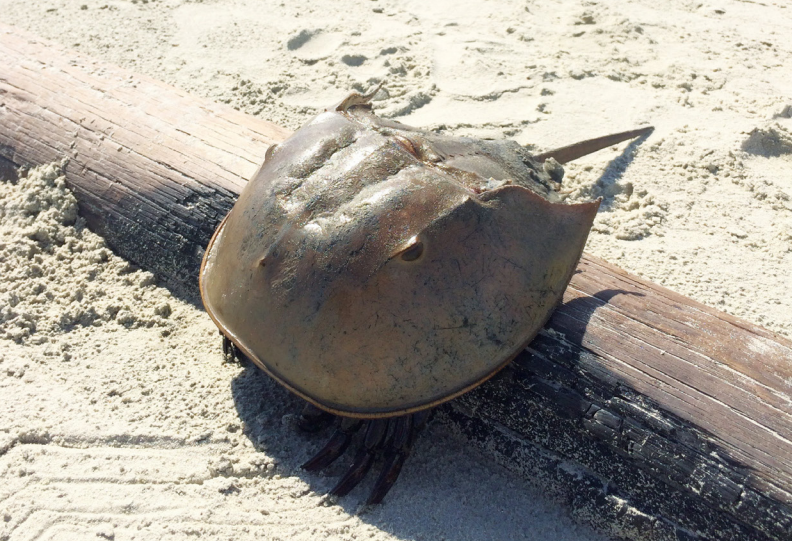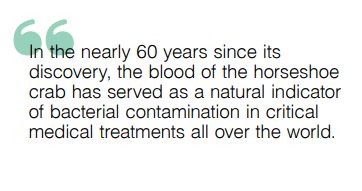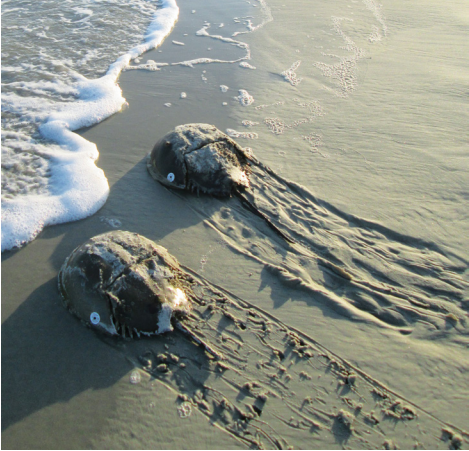The Horseshoe Crab: A Living Fossil
They bleed blue blood, scavenge the seafloor with 10 eyes, are most closely related to spiders and scorpions and are an indispensable part of modern medicine. Meet a creature older than the dinosaurs, right here on our beaches. By Jessie Hazard. Photos by Steve Rosamilia.
The large, tortoise-like shell of a horseshoe crab sits on the beach at Isle of Palms, water lapping at its edges. Some passersby knowingly sidestep the odd-looking remains even as their leashed dogs lurch eagerly toward them, but many beachcombers stop to peer and poke at the skeleton. Eventually, one puzzled man picks it up and fangs it, like a Frisbee, back at the open ocean. Within minutes, it’s washed back up and retaken its silent place among the bric-a-brac of the beach.
Kristin Linesch and Dr. Amy Fowler display some of their intriguing study subjects.
It’s odd that so many people don’t recognize the horseshoe crab, even though it’s one of nature’s most compelling wonders. These prehistoric creatures predate the dinosaurs, going back at least 420 million years— they survived the great Permian extinction that eliminated 96 percent of all marine species. Able to live for a year without eating, the horseshoe crab can endure extreme temperature conditions and salinity. These creatures have fought hard for their place in the world, and they have earned it. Yet these “living fossils,” while cherished for their biomedical properties and intrinsic to the food chain, may be exiting stage right. The International Union for Conservation of Nature has placed the Limulus Polyphemus, the only species of horseshoe crabs indigenous to the United States, on a “near threatened” status. They are still so understudied, however, that many scientists aren’t certain how endangered they are.
“People just don’t know much about them because they’re so hard to see,” says Dr. Amy Fowler, Assistant Marine Scientist at the South Carolina Department of Natural Resources, and the resident expert on horseshoe crabs. “It’s a blessing and a curse. Being a wallflower helps them stay away from harm, but it doesn’t make it any easier for us to help them.” If it’s your first time seeing one, Fowler has a few words of advice: “Don’t be scared. They look scary at first, but they are one of nature’s most gentle creatures. They really are extraordinary.”
A CRAB THAT’S NOT A CRAB
(Photo courtesy South Carolina Department of Natural Resources)
Although they got their name because it was thought they resembled the foot of a horse, these “crabs” aren’t crabs at all. A marine chelicerate arthropod, the horseshoe crab is more closely related to scorpions, spiders and ticks. It feeds upon marine worms and shellfish, small potatoes considering that the female horseshoe crab can reach up to 2 feet in length and can weigh up to 11 pounds. The smooth, brown shell often supports a mini-community of hitch-hiking marine life.
Everything from bacteria to plants to mussels and barnacles make homes there. By the end of the horseshoe crab’s full life—about 19 years, sometimes longer—the organisms that live on the outer surface can grow so much that the shell is no longer visible.
The body, divided into an anterior cephalothorax and a posterior abdomen, has five pairs of legs that function not only for moving, but also for eating. The middle segment of each leg is covered with spines used to chew food before it is passed forward and into the mouth located at the base of the legs. A special inherent grinding structure can even break down clam shells and sea urchins once they pass into the esophagus so that the crabs can absorb them as food. They’ve got ten eyes located all over their bodies (often on their backs or sides), but ecology’s cruel joke is that they still have poor eyesight, useful only in finding mates and sensing light. Finally, a spike-shaped tail functions as a tool for digging in sand and a spatula if the animal finds itself upside down.
Horseshoe crabs are one of the few animals that have no major predators—though their roe is an invaluable food source for many coastal seabirds (the red knot, a federally threatened shorebird, depends upon the crab to survive its migration) and they are sometimes lunch for the federally threatened loggerhead sea turtle and several shark species. Tat hard shell keeps them protected from nearly every adversary—except for us. People use them for eel and whelk bait, and while synthetic baits have been developed, the commercial bait industry still gathers hundreds of thousands of crabs every year. Here in South Carolina however, the species is protected and only hand-harvesting of horseshoe crabs for biomedical applications and marine research is allowed. There are also six island sanctuaries in South Carolina, making the creature one of the most protected species in our area.
STUDYING A SCIENTIFIC MYSTERY
As a crustacean biologist, Fowler and her teammates do consistent and cutting-edge research on the area’s commercially and recreationally viable crustaceans. Usually, that means they’re studying the shellfish we eat, like shrimp. They trawl the Charleston Harbor monthly to keep track of shrimp stock and behavioral patterns, using the data to dictate how and when the year’s shrimping seasons will come about. It’s hard work, but it’s much easier collecting data on shrimp than on horseshoe crabs. Horseshoe crabs are one of Fowler’s trickiest subjects, because the only time they venture to the shoreline is to spawn, which happens briefly in the late spring months, at night. Once they become fully mature, the crabs head into deep waters and hang out on the sandy ocean floor.
The shroud of mystery surrounding the crab’s life cycle is what makes them so hard to classify. Fowler’s team is working on unravelling that mystery however. They’ve partnered with the South Carolina Sea Grant to take genetic samples from individual crabs they find on 11 beaches stretching along the coastline, helping get a handle on the effective population size of a community of crabs, and learn about the health and longevity of that community.
The SCDNR has also instituted a tagging program that’s identified over 9,000 crabs since 1997. The tags are a way to track movements so that, eventually, scientists will be better able to find and study them throughout their entire life cycles. And that’s important, because horseshoe crabs give humans a priceless gif: their blood. Biomedically, horseshoe crab blood has sweeping implications on our health.
Instead of producing antibodies to battle infection, the crabs’ primitive immune system releases proteins that bind and kill the invading bacteria. You can thank horseshoe crabs for every infection-free vaccine you’ve ever had. The proteins detect endotoxins, a group of bacteria that is ubiquitous and incredibly hard to control. In the nearly 60 years since its discovery, the blood of the horseshoe crab has served as a natural indicator of bacterial contamination in critical medical treatments all over the world. Scientists have even discovered antiviral and anticancer components in the magic blood, which is worth over $15,000 a pint. If done right, the animals are not usually harmed during blood extraction, though there is a 15 percent fatality rate, usually because of the stress of transport to and from the bleeding center. One pint is the maximum amount a female crab can donate without dying, though the smaller males yield less. NASA has even taken horseshoe crab blood into outer space to help keep astronauts healthy. If an astronaut comes down with a sore throat, they can swab it and use a test kit made from the blood compound to see if it’s a bacterial or viral infection. “Tough they’ve tried since the Fifties to find a synthetic protein that can do what the crabs’ blood does, scientists still haven’t been able to produce anything that’s nearly as accurate as the real stuff,” Fowler says.
The next time you come across one of these wonderfully weird creatures on the beach, remember to thank them for the medical miracles they perform.




